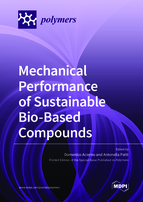Mechanical Performance of Sustainable Bio-Based Compounds
A special issue of Polymers (ISSN 2073-4360). This special issue belongs to the section "Polymer Analysis and Characterization".
Deadline for manuscript submissions: closed (20 December 2022) | Viewed by 102971
Special Issue Editors
Interests: polymeric materials and biomaterials; micro- and nano-particles; composites; material characterization; processing behavior; viscoelasticity; rheology; mechanical properties
Special Issues, Collections and Topics in MDPI journals
Interests: polymer-based composites; micro- and nanofillers; processability; rheological and mechanical characterization
Special Issues, Collections and Topics in MDPI journals
Special Issue Information
Dear Colleagues,
The global production of plastic is increasing, representing one of the most popular materials after steel and cement, and is widely spread in countless applications, from commercial and industrial fields to everyday life.
Experts predict, in 2030, millions of tons of plastics will be accumulated and dispersed in nature. Millions of tons of CO2 are also emitted into the atmosphere due to the production of plastics—the most traditional ones being derived from oil—and their final incineration.
In this context, scientific research should focus on alternative solutions for the sustainable development of production processes, including biomass waste valorization, the use of green technologies, avoiding risks for human health, and limiting the environmental impact.
Sustainable bio-based materials are a broad class of organic components from agro-food renewable resources (polysaccharides and proteins), bacterial activities (i.e., polyhydroxyalkanoates), conventional synthesis of bio-derived (i.e., polylactides and polyglycolides), or synthetic (i.e., polycaprolactones, polyesteramides, co-polyester) monomers. This category allows systems to meet current needs without dangerously burdening the future from the ecological, economic, and human point of view (sustainability). Biomaterials can be converted into chemical elements through the action of biological or physical agents (biodegradability), and can be also transformable into natural fertilizers for agriculture, once degraded (compostability). For specific applications, the ability to not be altered by biological fluid contact, reactions with human bodies, and the releasing of harmful species (biocompatibility) is important. Compounds can also be obtained by mixtures of natural lignocellulosic fibers (such as sisal, jute, cotton, linen, hemp, kenaf, jute, bamboo, etc.) and bio-based resins, by offering a possible option for the replacement of harmful glass- and carbon-based fibers in the field of reinforced composites.
Yet, the main restriction to the full development of these bio-based-formulations, in the restoring of the traditional plastics, is represented by the lack of good mechanical characteristics, derived by poor interfacial adhesion between the polar hydrophilic reinforcement and apolar hydrophobic matrix. Different strategies should be studied in order to adapt these systems to our needs and improve their efficiency.
This Special Issue will collect original contributions, both research papers and reviews, showing recent results and/or positive advances in the behavior of new sustainable bio-materials under applied mechanical stress, both in static and dynamic mode, and evaluating the characteristics of resistance, moduli and/or viscoelasticity, in view of potential applications, such as tissue engineering, medical devices, surgical, or dental implants, manufacturing of human parts, agriculture, packaging, textiles, electronics, automotive and aerospace, green buildings, and architecture and construction.
Prof. Dr. Domenico Acierno
Dr. Antonella Patti
Guest Editors
Manuscript Submission Information
Manuscripts should be submitted online at www.mdpi.com by registering and logging in to this website. Once you are registered, click here to go to the submission form. Manuscripts can be submitted until the deadline. All submissions that pass pre-check are peer-reviewed. Accepted papers will be published continuously in the journal (as soon as accepted) and will be listed together on the special issue website. Research articles, review articles as well as short communications are invited. For planned papers, a title and short abstract (about 100 words) can be sent to the Editorial Office for announcement on this website.
Submitted manuscripts should not have been published previously, nor be under consideration for publication elsewhere (except conference proceedings papers). All manuscripts are thoroughly refereed through a single-blind peer-review process. A guide for authors and other relevant information for submission of manuscripts is available on the Instructions for Authors page. Polymers is an international peer-reviewed open access semimonthly journal published by MDPI.
Please visit the Instructions for Authors page before submitting a manuscript. The Article Processing Charge (APC) for publication in this open access journal is 2700 CHF (Swiss Francs). Submitted papers should be well formatted and use good English. Authors may use MDPI's English editing service prior to publication or during author revisions.
Keywords
- Bio-based polymer
- Green composites
- Green technologies
- Low environmental impact
- Biodegradability
- Biocompatibility
- Natural fiber-reinforced composites
- Biomass waste valorization
- Mechanical characterization
- Strength
- Viscoelasticity
- Rheological behavior








